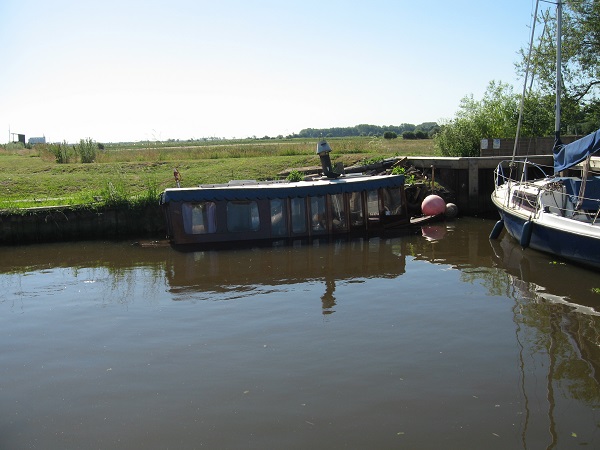 The month started with a sizzling heat wave. The Gremlins, unused to such weather decided a swim would be in order, inside Banjo. A sorry sight when we arrived Tuesday morning for a day's sailing. The tide would be flooding for the next four hours so we sailed away, looking forward to an evening baling! Joyfully, on our return we found Capt. Liberte had dropped in a mains electric pump, job done, except for the wet seats etc. . The heat wave worked for us then for by Friday, nearly everything was back to normal. Cruised up to Surlingham and lunch ashore and overtook the Albion, the wherry that tried to catch us on Breydon. We offered them a tow, naturally, but our thirst overcame chivalry!
The month started with a sizzling heat wave. The Gremlins, unused to such weather decided a swim would be in order, inside Banjo. A sorry sight when we arrived Tuesday morning for a day's sailing. The tide would be flooding for the next four hours so we sailed away, looking forward to an evening baling! Joyfully, on our return we found Capt. Liberte had dropped in a mains electric pump, job done, except for the wet seats etc. . The heat wave worked for us then for by Friday, nearly everything was back to normal. Cruised up to Surlingham and lunch ashore and overtook the Albion, the wherry that tried to catch us on Breydon. We offered them a tow, naturally, but our thirst overcame chivalry!
IF the battery had kept the pump a'pumping'
IF the coal had not been used from starboard side,
IF the leak had been addressed when first was noticed,
Then the Gremlins would have missed their gala day.
The low ebb proved no problem to the re-hashed trailer. The new axles with smaller wheels, the drawbar dolly and extension pole made recovery a doddle, home by coffee break and repair to the leaky plank half done. After lunch the fire tubes were given a birthday treat inside and out.
Damage from the total immersion is a lot less than feared. A few rusty bits and a bit of mud is only to be expected, but electric rev counters do not like it! A mechanical model is to hand, but a higher mounting point is being considered. However, after stripping and a few days dry out we seem to have revs again.
During this week's 'rest' I have made the helm's and engineer's windows open outwards. I hope now that they will be rain proof. The extra couple of inches freed up inside will also be welcome, Banjo is fairly slim amidships, 4'6” for two adults and an engine.
The rainproof windows have had their test, and they are draught proof as well. We had the pleasure of following the fleet on the down river race to Reedham. The fore cast was for rain and wind so we had a good excuse not to sail! On the way back we had the pleasant company of the Club newly weds, Steve and Sara. The foul weather could have strained relations a bit, but a ride home in the warm dry saloon on Banjo, will, I am sure, be a pleasant memory, for all.
The last day of the month and summer has returned. The record temperatures, high and low, plus the extreme rainfall and wind certainly tested the windows. Another job I should have done years ago.
Our last trip of the month, with the 'guest stoker' restricted to 160psi, a pleasant cruise up river to Whitlingham for lunch aboard. An 'all in' with fruit and custard, home brew and coffee. Tomorrow we are steaming again, giving rides to disadvantaged club guests.

